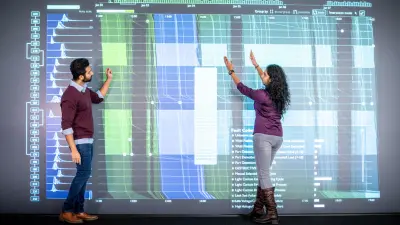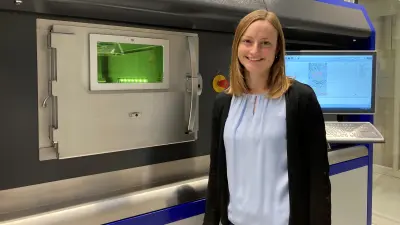“It’s like I’m learning a new language”
Artificial intelligence training initiative

Máté is developing components for driver assistance systems in Hungary, Michael is researching the noise behavior of steering systems in the U.S. Both are taking part in the Bosch Center for Artificial Intelligence (BCAI) training initiative — and are thus making themselves fit to work with artificial intelligence.
BCAI's training initiative prepares employees to work with artificial intelligence (AI). One of BCAI's many training offerings is the 18-month expert program, in which employees develop into experts in data engineering and data science.
Máté Szűcs, Group Manager Mechanical Engineering
“In a few years, software competence will be standard for every engineer”, says Máté. As part of the expert program, the group leader is training to become a data engineer. A data engineer's job is to organize, cleanse and make data available to others for use in training an artificial intelligence, for example. “As a leader, I feel a responsibility to educate myself in the field and be a role model. I didn't know anything about professional software development”, he says. “That's why I was so interested in the program. It's like I'm learning a new language.”
Máté and his team in Budapest are responsible for the development of components in driver assistance systems. During tests, they are exposed to vibrations or extreme temperatures, for example. In the future, the test reports should be generated automatically. He is bringing this project into the advanced training program to become a data engineer. The idea: “The data pipeline begins with the collection, conversion and structured storage of raw data. By means of AI, relevant data is automatically printed in the report, which only needs to be reviewed by a human”, he says. This can save time and money and help improve quality, he adds.

Martin Thomas, Training Manager (BCAI)

Over a period of one and a half years, employees undergo further training in a fixed group as part of the expert programs. In addition to theory, they contribute a practical issue from their everyday work. Anyone selected for the program can spend 30 percent of their working time on it. The department covers the costs.
By 2025 all Bosch products should either contain AI or have been developed or manufactured with its help. “Accordingly, the number of associates who deal with the topic must also increase significantly”, says Martin, who is responsible for training. “We have offers for beginners and experts”, he explains. These include online trainings as well as training courses for managers. To get started, there's the ‘BCAI Learning Platform’, where participants can complete virtual courses on their own. These include an introduction to statistics, neural networks and time series analysis.
Michael Sturm, Engineer
The expert programs are particularly intensive. Michael has taken part in these. “I really like the fact that I can contribute my expertise here”, he says. The 41-year-old researches in Plymouth when and where noises occur during steering and how they can be prevented. He introduces this question to his training as a Data Scientist. Simplified, a Data Scientist draws knowledge from large amounts of data.
“The data we collect in our measurements must be analyzed using modern methods”, explains the engineer, who studied mechanical engineering and mechatronics. Artificial intelligence can be used to predict how the steering will behave at the customer's site and on the road, he says. “In ten years, mechanical engineering will no longer exist in its current form. Nothing will be sold there without software in the product”, he says. “Machine learning will be the standard then. So this is the right time to deep dive into it.”

Tobias Freundorfer, Software Engineer

Tobias has already completed the program — and has been trained as a data engineer. “I particularly liked the combination of theory and practice”, says the software engineer, who already had prior knowledge from his studies. He works in Feuerbach on a project in the field of Automated Valet Parking (AVP), which he brought into the practical phase. “We have various databases in which data from drives is saved”, he says. “The goal was to centralize this data, thus enabling more advanced solutions.”
Tobias introduced a new tool to analyze data for the parking garage at Stuttgart Airport, where AVP is being tested and developed. “The market for IT professionals and especially data engineers is small, but the demand is very high”, he says. “I believe it is the right way to acquire these skills. On the way to becoming a data-driven company, Bosch needs people who want to become experts in it.”
Jasmin Dippert, Data Scientist
“I was already programming in my studies and in my free time”, says Jasmin. She was trained as a Data Scientist at Bosch and then moved to a new position. Previously, she worked as an engineer in process development and, among other things, worked on live process monitoring in 3D printing — one of two projects she contributed to the AI training. The goal: an artificial intelligence that uses photos, taken during printing, to detect when a part is about to come out of the 3D printer defective and sounds the alarm. Two mentors from BCAI were on hand to advise her. Her project will now continue in the business unit. In her new job, she is using the skills she learned in stationary fuel cell production. “I'm glad I took the chance and started something new like this.”

Mai Lan Ha, Data Scientist

In order to be able to offer programs that are as customized as possible, the BCAI implements the training and further education itself — and relies on its own teachers. Mai Lan Ha trains employees at the Bosch Center for Artificial Intelligence (BCAI) in Renningen to become Data Scientist. “Turning your own people into teachers is a great idea”, says the scientist, who did her PhD at the University of Siegen and already has experience in training. “The combination of industry and research really makes sense, as each area benefits from the other.” As a teacher, she also gets in touch with topics and projects in the expert program, through which she continues learning. “As a trainer, I also have to constantly renew my knowledge.”